North American Pre-Orders Opened for TPCast’s Wireless Adapter for HTC Vive
by Anton Shilov on November 13, 2017 1:00 PM EST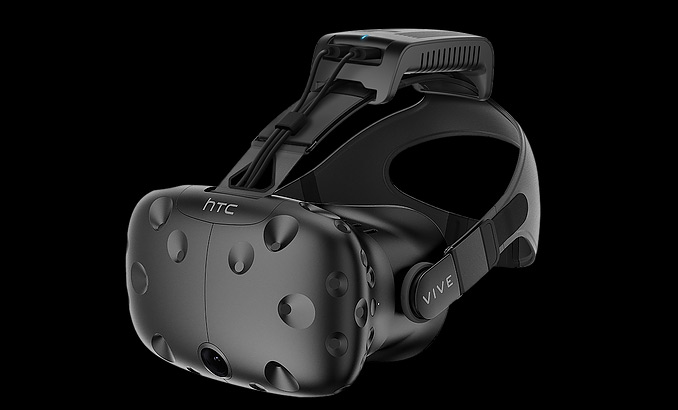
TPCast has finally begun to take North American pre-orders for its wireless headset adapter for the HTC Vive. Already released in China, the unit offers untethered operation of the HTC Vive for five hours as well as minimal latencies. The cost for this wireless motion is $299.99, and the company plans to begin shipments of the device later this month.
TPCast’s wireless adapter for Vive uses 60 GHz and other radios to connect the VR headset to the PC and thus eliminate cables, one of the major drawbacks of today’s high-end VR gear, and enables a greater freedom of movements for gamers. Common sense for most users put wireless connections as having a higher input lag that wired interconnections which may affect user experience, although TPCast claims to have solved this. It claims that the wireless adapter has an input latency of 2 ms, which is lower than “<7ms latency” featured by HTC’s wireless accessory for Vive created with Intel.
The relatively low latency of TPCast’s wireless adapter for Vive is enabled by Lattices’ MOD6320-T/MOD6321-R WirelessHD modules that are used to transmit VR display content from PC to the headset. Speaking of Lattice, the device also uses Lattice’s SiI9396 600 MHz HDMI bridge ICs and LatticeECP3 SERDES-based FPGA, so the company is a key developer of chips for the adapter. Neither TPCast nor Lattice disclose actual transmission rate that is used for the wireless adapter for Vive, but we know that the WirelessHD is speced for 10 – 28 Gbps, well in excess of the 8.2Gbps required for the Vive's hardware HDMI 1.4 connection..
The TPCast Wireless Adapter for Vive kit consists of several pieces: the transmitter module that plugs to the Vive Linkbox (which is connected to the PC), the receiver that connects to the Vive headset, and an Anker PowerCore 20100 mAh (100.5 Wh) accumulator that provides up to five hours of battery life to the head mounted display. (interesting aside: at that capacity, it cannot be taken on-board aircraft.) The unit also comes with a charger, a router and a bunch of cables to make setup easier. It is noteworthy that TPCast requires customers to use its own router because it transmits information back from the HMD to the PC.
The TPCAST Wireless Adapter for Vive is now available for pre-order, at a price of $299.99, via Amazon, Newegg, and the company’s own website. TPCast plans to start shipments of the device on November 24 (for some reason, Newegg mentions November 20 as the release date), so expect retail availability of the unit after this date.
Related Reading:
- HTC & Intel Partner on WiGig Wireless for Vive VR Headset
- HTC Offers Vive + GeForce GTX 1070 + Fallout 4 VR Bundle for $799
- Logitech and HTC Team Up to Integrate Physical Keyboards Into VR Environments
- HTC Permanently Cuts Price of Vive to $599
- HTC Announces New Standalone Vive VR Headset with Google Daydream Support
Source for the diagram: UploadVR
Source: TPCast


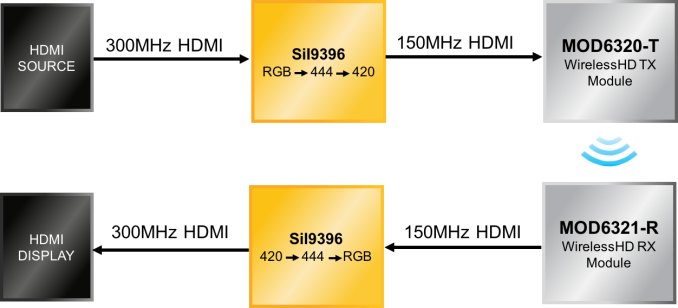
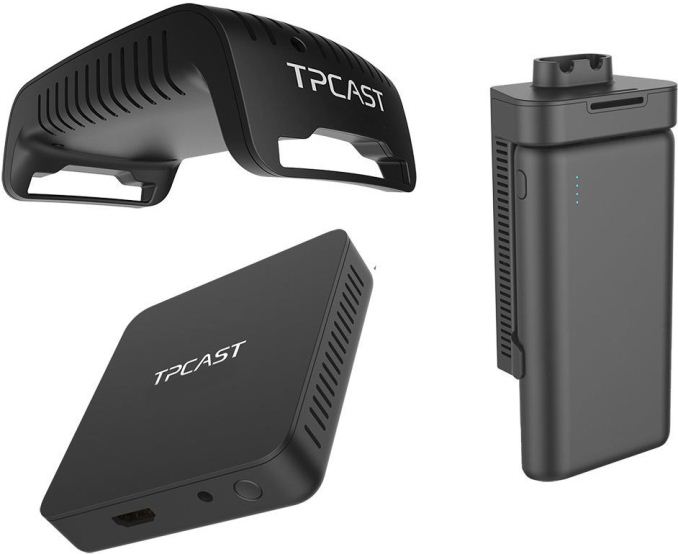
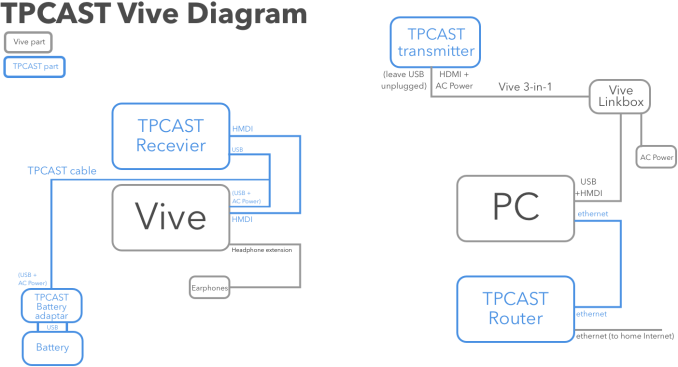
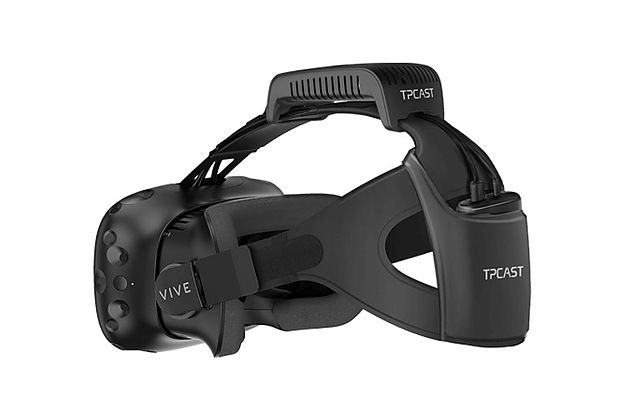








28 Comments
View All Comments
JoeyJoJo123 - Monday, November 13, 2017 - link
Looks okay. The proprietary router and $299 price is kind of offputting. It's also probably a bit cumbersome to have _even more weight_ to your head.Realistically should've been attachable to a user's upper arm, back, or waist. The Vive headset is already pretty heavy as-is for sessions longer than an hour or so.
PeachNCream - Monday, November 13, 2017 - link
I don't have a Vive so I don't know for sure, but would the fact that some of the extra hardware ends up on the back of the head and the rest on the top balance out the Vive? It looks front heavy so maybe changing how weight is spread around would offset some of what your head and neck will have to carry.JoeyJoJo123 - Monday, November 13, 2017 - link
Not sure, it might help balance it, but I know that many friends and family members prefer contacts to glasses because even thin-frame glasses end up feeling like they get in the way, and those don't have an implicit weight issue.I imagine it's kind of the same deal here. If someone finds reading glasses uncomfortable, then I don't think adding weight behind the person's head really helps alleviate that.
I think if the interest is in a truly untethered and free experience, as long as you have the bulk associated with the displays and lenses in front of the face, it'll still feel like it's in the way or isn't natural. But obviously even VR in the form-factor of reading glasses is a long-long-long ways off.
In the short term, I think finding ways to offset the weight from the head would help getting towards that goal.
Lord of the Bored - Tuesday, November 14, 2017 - link
Actually, the "glasses issue"* is why they use the big three-strap assemblage. The upper strap is key to keeping the headset's weight from pressing down on the nose and lower face. It still isn't optimal, but...*I can't really judge this issue fairly, as I've been wearing fairly powerful glasses for most of my life. I feel weird WITHOUT them.
Handi101 - Wednesday, December 13, 2017 - link
When properly worn, the front weight is not that bad. You don't want it so tight that it imprints itself on your forehead. The Vive now ships out with a new updated head strap that is much more comfortable. It makes me think of the hard hat with a tightening knob on the rear. Very comfy.Handi101 - Wednesday, December 13, 2017 - link
The commercial version that is being sold and delivered does not have the battery and power portion on the back of the headset. It is mailed out with a mesh type of bag and nylon strap that goes around your waste.piroroadkill - Tuesday, November 14, 2017 - link
Occlusion problems. It needs to have direct line of sight as often as possible.Handi101 - Wednesday, December 13, 2017 - link
That is true. The module of the TP CAST that transmits the signal to your head works better if it is right above you. Hooking it up like it says in the directions isn't always best. I often block the line of sight by merely looking up.Handi101 - Wednesday, December 13, 2017 - link
The TP Cast portion that sits on your head only weighs 3 oz. I have worn the Vive set up like this for over an hour and did not even notice it up there.Danvelopment - Monday, November 13, 2017 - link
Someone has been typing HMD and HDMI too long.Can someone explain the router? I don't understand why that exists or is required. Transmitter > receiver. What does the router do?